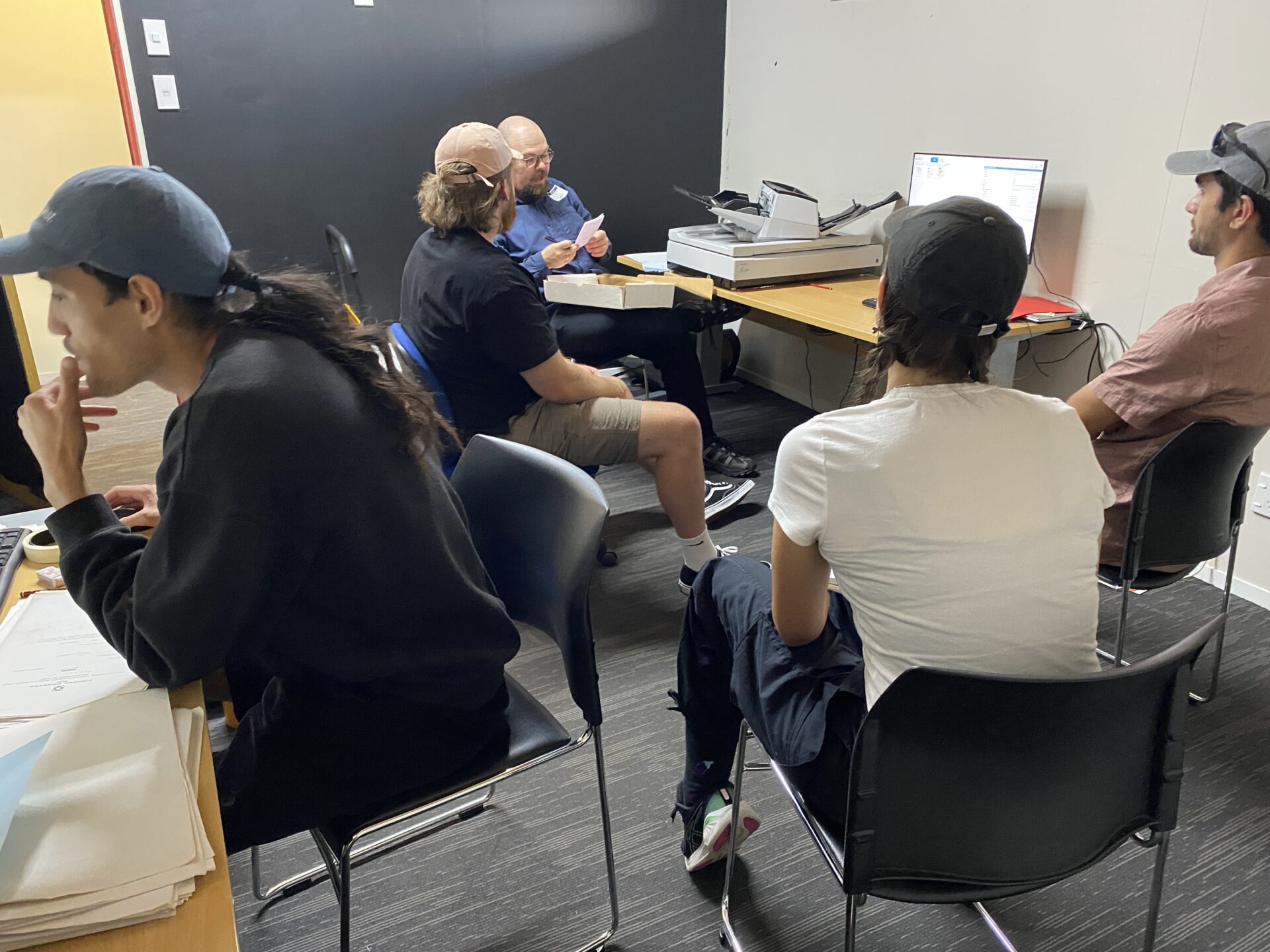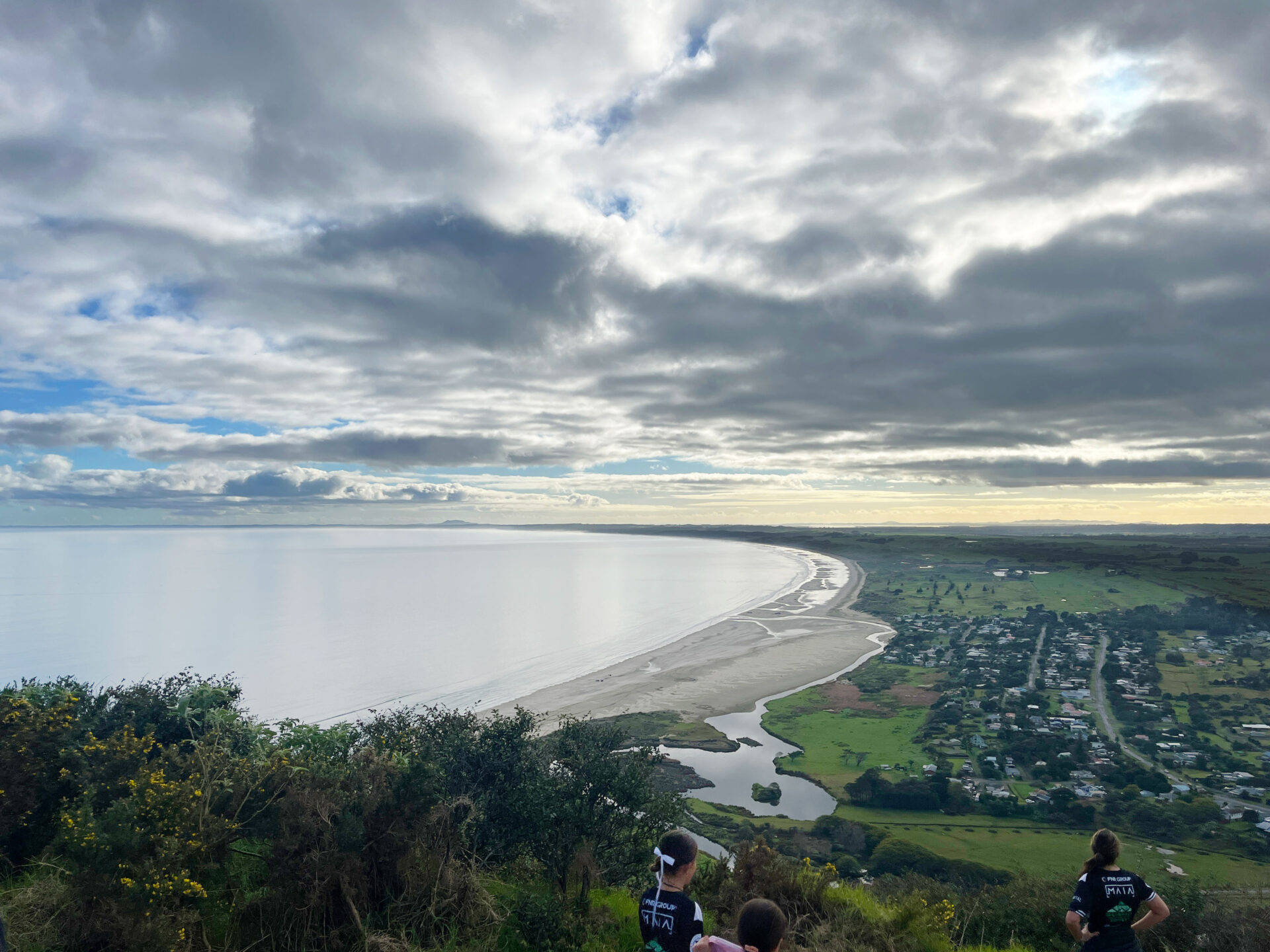NZMS first heard about a move to create a digital archive for Te Rūnanga o Te Rarawa in 2022 when Whina Te Whiu emailed Alison Barnett, NZMS Northern Regional Manager: “The time has come for the iwi to digitise their post settlement iwi collections.”
Te Iwi o Te Rarawa is a confederation of hapū based in the Far North, comprising a foundational 23 hapū marae, each with its own unique identity.1 The brief written history on the Iwi website outlines how they have approached this since their 1986 establishment, offering a rare insight into the challenges and struggles facing an iwi in creating a strong and representative executive.
We were soon to learn that planning for the archives project had been underway for some time and Whina had been appointed by Te Rūnanga to start scoping the work. Whina is ideally placed for this mahi; a highly qualified archivist and librarian who affiliates to Te Rarawa. She has a Graduate Diploma of Heritage and Museum Studies and a Bachelor of Māori and Information Management and is recognised as a Taonga Māori and Documentary Heritage Specialist. Whina was the Project Manager for Ngā Upoko Tukutuku / Māori Subject Headings development project established by LIANZA, Te Rōpū Whakahau, and the National Library in 2006 and, more recently she has worked as Curator Manager at Te Ahu Museum in Kaitaia since 2017.2
In her Archives and Heritage Collections Condition Report, produced in support of the project, Whina links the establishment of Te Rūnanga o Te Rarawa to the establishment of the Waitangi Tribunal on 10 October 1975, outlining the arduous process of developing and accumulating evidence:
… through thousands of hours of hui, the collecting of oral histories and video recordings; gathering of original manuscripts and conducting in depth research in museums, archives and libraries around Aotearoa. Thus, creating the most comprehensive collection of Te Rarawa Iwi history, whakapapa and identity in the world.³
The report went on to express the challenge they were now facing:
Today, the dilemma the iwi faces is firstly, their ability to respond to the needs of iwi members living outside the iwi landscape and environs, living in other parts of Aotearoa and other countries and their desire to connect, whilst the iwi must consider; their capacity and capability to fulfil the values of kaitiakitanga in its fullness in regards to the care and access to these unique iwi collections.
Te Rarawa General Manager Paulette Montino, Rūnanga Te Reo Consultant and Kaihautū Mike Te Wake, and Rūnanga Te Matarau Ellen Graham developed an initial project plan and identified appropriate partners to work alongside the iwi in building internal capability. Soon after, a ‘crack’ team was recruited for this mahi and the project was promoted by the Far North District Council including in this video.4
The project plan Te Rarawa developed highlighted several aspects required for internal capability-building and the proper exercise of kaitiakitanga, from assessing physical material and rehousing in conservation boxes and enclosures, to setting up a digitisation facility and training Te Rarawa staff in digitisation and metadata creation. The Rūnanga team also chose Recollect as their online content management and engagement platform so that Iwi members would have access to the digitised records, wherever they might be living.
NZMS’ Marc Thompson and Alison Barnett made the first trip to Kaitaia in early November 2023 to fully scope the collection, counting through boxes and folders to confirm what equipment would be required, how much data storage would be needed, and which space might be converted to a digitisation suite.

Above: Week 1 training underway January 2024. Left to right: Kee-Lin, Danaan, Marc, Kendra and Kevin. This was Kevin and Danaan’s second day on the job!
They returned with another NZMS colleague, Kendra van der Merwe, in January 2024, and again in May, working alongside the Rūnanga digitisation team Kevin Harrison, Kee-Lin Snowden and Danaan Beatson who arranged and described the archives, created metadata under Whina’s guidance, and fitted out the chosen space in their Rūnanga offices in Kaitaia for both camera and scanner digitisation. Kee-Lin described the sense of responsibility: “It can really be quite profound, and sometimes it can be really heavy where a karakia is needed, but the majority of the time it is smooth sailing and calm.”5
All three Rūnanga kaimahi are fluent in Te Reo, with Kee-Lin and Danaan having gone through full immersion Kura together. Kevin’s experience in Māori broadcasting was invaluable as training interwove descriptive work, metadata, technical digitisation requirements and standards, as well as encompassing the Recollect implementation work. Danaan’s skill and experience gained through studies at Toihoukura Māori Visual Art and Design School in Gisborne, led to a new graphic design for their Te Oha – Whakaputunga Taonga Recollect site.
By the end of the project, the Rūnanga team had established a robust digitisation workflow from initial material assessment to ingest into Te Oha culminating with the site’s official launch on 27 June during Matariki this year at Te Ahu Museum in Kaitaia.
The launch marked a significant milestone for all participants. For NZMS it was the end of multi-faceted 10-month project during which we provided the hardware and software, expertise and training, and ongoing support needed for the iwi to create and build in-house digitisation capability. For Te Rarawa, the launch was the realisation of a long-held vision to protect their archives and create better access, develop internal technical capability and, ultimately, control their own narrative.
This week of Te Wiki o te Reo Māori with its theme of ‘Ake ake ake – A Forever Language’ is an opportunity to celebrate Te Rarawa and its seminal archives project. The theme represents “the resilience, adaptability and endurance” of the language and “the commitment New Zealanders have to embracing and learning te reo Māori long into the future.”6 Another translation of ‘Ake, ake, ake’ is ‘as long as it takes’, a phrase synonymous with endurance in the context of Māori protest and fitting in the context of the work Te Rarawa have been doing for decades in reclaiming Te Reo, setting up full immersion Te Reo schools and now showing the 3rd highest level of students learning Te Reo in Aotearoa New Zealand.7 The immediate and concrete benefit being evident with the appointment of Kee-Lin, Danaan and Kevin.
And, in reflecting on these ideas, several other strands emerge in this story. For example, Whina’s earlier work with Ngā Upoko Tukutuku can be seen in this iwi-led archival space, which uses Māori Subject Headings. In addition, Te Oha has been configured to meet the needs of the Iwi and its hapū marae, ensuring that access to content is based on hapū marae affiliations, which are managed through the tribal registration system. Further, in tracing the establishment of the Rūnanga to the Waitangi Tribunal, it is satisfying to remember that the Waitangi Tribunal itself was established as a result of the Treaty of Waitangi Act (1975), passed into law in large part due to the activism of another Te Rarawa Iwi member, Dame Whina Cooper ONZ DBE.8 Dame Whina’s 1975 Hikoi began from in Te Hāpua in the Far North on 14 September – then known as Māori Language Day – but becoming the beginning of Māori Language week from 1975 onwards.
The work of building connection, context and understanding is well expressed in this whakataukī by Kukupa Tirikatene:
E kore e taea e te whenu kotahi ki te raranga i te whāriki kia mōhio ai tātou ki a tātou.
Mā te mahi tahi o ngā whenu, mā te mahi tahi o ngā kairaranga, ka oti tēnei whāriki.
I te otinga me titiro tātou ki ngā mea pai ka puta mai a tana wā, me titiro hoki ki ngā raranga i makere nā te mea, he kōrero anō kei reira.
The tapestry of understanding cannot be woven by one strand alone. Only by the working together of strands and the working together of weavers will such a tapestry be completed. With its completion let us look at the good that comes from it. In time we should also look at those stitches which have been dropped, because they also have a message.
NZMS kaimahi felt immensely privileged to be able to partner Te Rarawa in this archiving project and thoroughly enjoyed the opportunity to spend time in the Far North.
We wish them every success and look forward to working together in the years to come.
We close with a final note from Te Oha:9
Our identity as Te Rarawa is deeply rooted in our history, language, culture, and traditions. Preserving and understanding these aspects are essential for our continued existence as a people. By recognising and embracing our individual and collective identities as iwi, hapū, and whānau, we strengthen our connection to our land and heritage, which transcends physical boundaries.

Above: View up along the Ahipara beach coast on June 29, from the top of the maunga Whangatauatia during the annual Matariki Hikoi to the summit, where walkers were treated to a talk about the cultural significant of the site for Te Rarawa.
Footnotes
- Ngā Marae me Ngā Hapū, Te Rarawa website, https://www.terarawa.iwi.nz/nga-marae-o-te-rarawa/, (accessed 16/9/2024)
- “New Kaitaia Museum Curator has Big Plans”, The Northern Advocate, 21 November 2017, https://www.teaonews.co.nz/2024/06/06/preserving-traditions-and-history-for-future-generations-of-te-rarawa, (accessed 12/9/2024)
- Te Whiu, Whina, “Te Rūnanga O Te Rarawa Archives and Heritage Collections Condition Report”, 12/10/2022, unpublished internal Te Rarawa document.
- “Video – New tech preserves the past”, 27 February 2024, Far North District Council website, https://www.fndc.govt.nz/Whats-new/Latest-news/VIDEO-New-tech-preserves-the-past ,(accessed 13/9/2024)
- “Preserving traditions and history for future generations of Te Rarawa”, by Muriwai Hei, Te Ao Māori News, 6 June 2024, https://www.teaonews.co.nz/2024/06/06/preserving-traditions-and-history-for-future-generations-of-te-rarawa, (accessed 13/9/2024)
- “Ake Ake Ake A Forever Language, Kia Kaha Te Reo Māori”, Te Taura Whiri i te Reo Māori, The Māori Language Commission, ReoMāori
- “Māori school students learning Te Reo at the highest level of immersion in New Zealand”, Figure.nz website, 1 July 2023, https://figure.nz/chart/5S3ETKXpoz2E6m4C, (accessed 13/9/2024) website, https://www.reomaori.co.nz, (accessed 12/9/2024)
- “Celebrating Dame Whina Cooper and the fight for Māori land rights”, New Zealand Parliament website, 9 Dec 2020, https://www.parliament.nz/en/get-involved/features/celebrating-dame-whina-cooper-and-the-fight-for-maori-land-rights, (accessed 12/09/2024)
- “Te Oha o Te Rarawa”, Te Oha – Whakaputunga Taonga site, https://teoha.terarawa.iwi.nz/pages/about, (accessed 12/09/2024)
